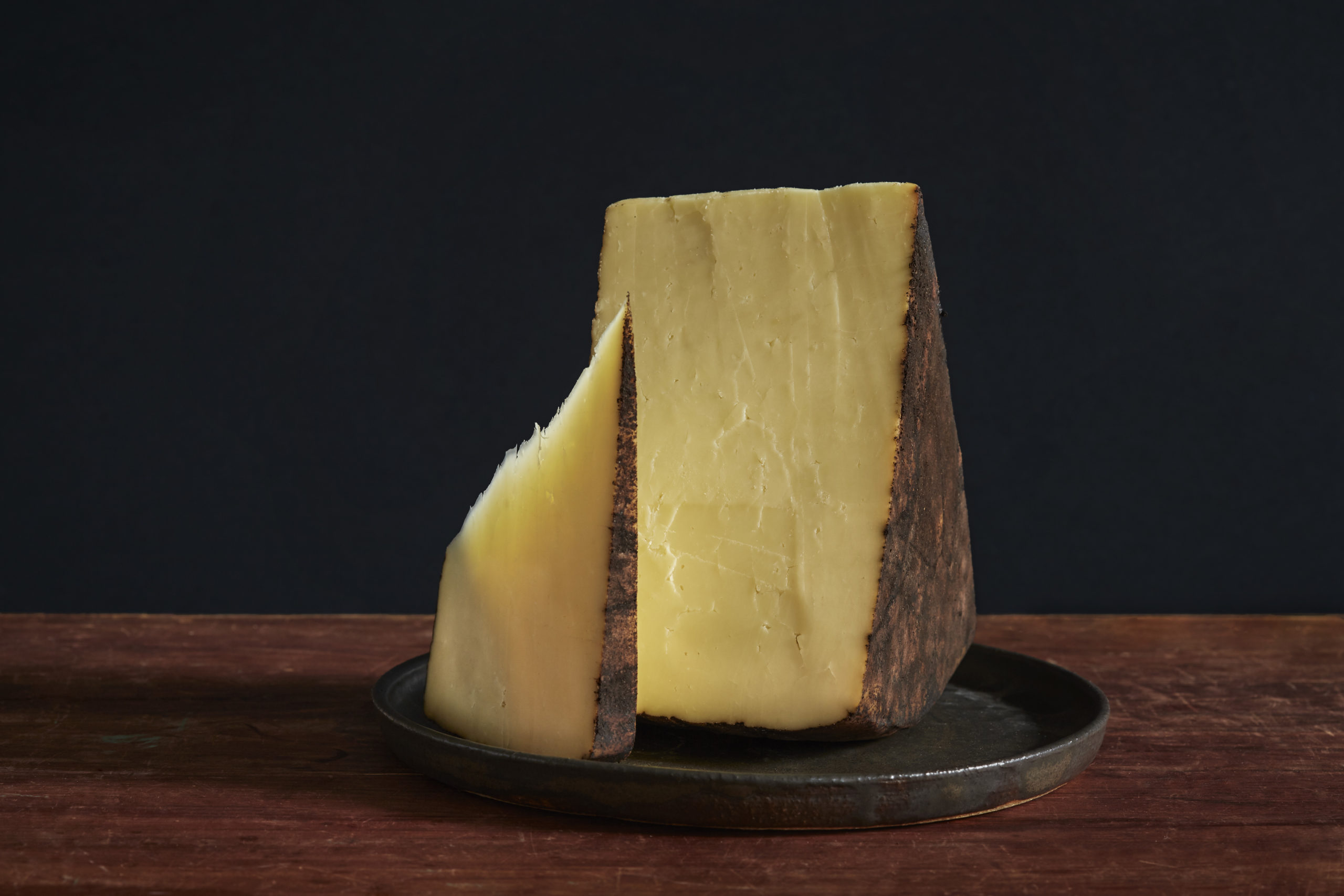
Beehive Barely Buzzed
Photographed by Nina Gallant | Styled by Chantal Lambeth
First things first: “Cheddar” is a verb, and cheddaring is a specific step that can be taken during cheesemaking. Cheddar cheese begins with the basic steps common to all cheesemaking: acidification, coagulation, cutting, and stirring. It’s the cheddaring, or formation of curd slabs, that makes this cheese different. As whey is drained from the vat, islands of cheese curd are exposed and begin knitting together into a solid mat. Sometimes this occurs at the bottom of the vat, and other times on a nearby tabletop. The warm curd-mat is then cut into smaller slabs that are stacked, unstacked, and restacked with the intention of pressing out additional whey and delivering a firmer, drier curd. Simultaneously, acidity develops during the cheddaring process, and when it reaches a ballpark pH of 5.2 to 5.5, the slabs are milled—run through a sausage grinder of sorts—into finger-sized batons. The milled curd is salted, which slows the development of acidity, and then formed and pressed for aging.
This traditional method is named for the town of Cheddar in Somerset, England, where the cheese originated. (The earliest recorded mention of cheddar appears in an account of the English King Henry II, who purchased 10,240 pounds of cheddar in 1170 at one farthing per pound, or about £2 per ton.) Plentiful salt supplies and an abundance of moderate- to high-acid milk meant that the English cheese did not require the intensive curd cutting and high temperature cooking necessary for Alpine cheeses such as Gruyère and Comté. Unlike those aged cow’s milk cheeses, cheddar took on a sharper, saltier flavor with a texture not so much smooth and bendy as firm and chunky.
The durable and long-lasting Somerset cheese that was well suited for transportation to London’s urban markets was also a food fit for the burgeoning American colonies. Although the Pilgrims of Plymouth Colony began importing cows to Massachusetts in 1623, it was the arrival of the Puritans and the 1629 establishment of the Massachusetts Bay Colony that secured cheddar as the dominant American cheese. As land prices rose and farmers moved north and west, the cheese of Somerset followed. Before the 20th century advent of processed cheese food known as “American cheese,” cheddar was the national standard.
Although it’s effective, traditional cheddaring is slow and labor intensive, making the process expensive and less scalable for factories interested in producing increasingly larger amounts of cheese. Very few American cheesemakers still cheddar and mill their curd; notable exceptions include Beecher’s Handmade Cheese in Seattle, Washington, Shelburne Farms in Shelburne, Vermont, and Fiscalini Farmstead Cheese in Modesto, California. These days, most cheddar is made using a process called “stirred curd.”
Curd stirring is a quicker, more “efficient” cheesemaking process wherein the classic stacking and unstacking methods, followed by milling, are replaced by the practice of draining curd slabs on an open table. The curds are then cut and stirred to remove whey, reach target acidity, and prepare the curd for forming—this means that a cheddar doesn’t necessarily need to be cheddared. The FDA however allows a cheese to be labeled cheddar if it merely conforms to prescribed levels of moisture and milk fat. And those levels can be reached with either of the two different cheesemaking techniques.
In the past ten years English cheddar (also known as clothbound or bandaged cheddar) entered the American food lexicon. Radically different from block cheddar in appearance, texture, and flavor, clothbound cheddar is formed into cylinders weighing anywhere from 15 to 50 pounds, then wrapped in permeable cheesecloth and aged in temperature- and humidity-controlled cheese caves. (The first English cheddars were actually aged in subterranean caves that dot the Somerset countryside). The resulting wheels arrive at market in cloth wrapping the color of potato skins, with a drier, more crumbly paste, compared to the moist pliability of block cheddar. The flavors are never as mild as that of young block cheddar, nor do they approach the aggressive prickle many Americans know as “extra sharp.” Instead, they are celebrated for their earthy aroma, not unlike that of a root cellar, and rustic flavor profile, which can be vegetal or toasted, nutty or downright candied.
So what makes a cheddar a cheddar? Once the answer was simple; according to English tradition only cheeses made within 30 miles of Wells Cathedral were considered authentic cheddars. Certainly that definition no longer applies, nor does the classic cheesemaking technique of cheddaring. If anything, what matters most is the milk profile and culture blend that are present from the beginning. After that, it’s up to the individual intention of cheesemakers, which is what makes American cheddar a fascinating and expanding landscape worth tasting through again and again.
Age Related
Just as time and culture ratios transform block cheddar without the aid of oxygen, clothbound cheddars
begin to assume their full glory during 9 to 14 months in the open air of aging caves. By the time Cabot Clothbound leaves the creamery for maturing at the Cellars at Jasper Hill, they’ve been cooled for two to three days and pressed into a fine cheesecloth with a weave like muslin. At The Cellars the first step of aging is a brushing with melted lard. (Beecher’s uses melted butter for its Flagship Reserve.) For the next thirty days the wheels are flipped daily to ensure even moisture distribution and the beginning formation of a rind.
The wheels are then deposited on pine shelves in an enormous aging room kept at precisely 52°F and a relative humidity of 88–92 percent. In the aging room, the thin layer of lard acts as both a semipermeable membrane, allowing some moisture evaporation, and a food supply for ambient molds that colonize the rind. Over time, the molds dapple each wheel in an abundance of gray, brown, white, and ocher fluff, continuing to break down the exterior of the cheese and enabling more air exchange. These naturally developed rinds also attract cheese mites, which feast upon molds and impart a honeyed aroma to the dank cave smells. Although diatomaceous earth is approved for the control of cheese mites, most American artisan cheddar makers choose to manage these microscopic pests by brushing the wheels regularly, a tedious and costly undertaking.
Tasting Notes
Cabot Clothbound
Cabot Creamery/The Cellars at Jasper Hill
Vermont
Browned butter and caramel notes are underlined with a noticeable tang. Texture varies with age but tends to be open, and slightly crumbly.
Beecher’s 4-Year Aged Flagship
Beecher’s Handmade Cheese
Washington
Mellow, savory flavors include boiled eggs and buttered toast, with hints of butterscotch. Ever so lightly crumbly.
Shelburne 2-Year Cheddar
Shelburne Farms
Vermont
This ivory colored, blockstyle cheddar is relatively high in moisture with a smooth, close texture. Complexity, breadth, and piquancy define the flavor.
Fiscalini Bandage Wrapped Reserve
Fiscalini Farms
California
Made with traditional cheddaring techniques, this clothbound has a firm, crumbly paste with slightly smoky flavor and earthiness to finish.
Widmer’s Six Year Old
Widmer’s Cheese Cellars
Wisconsin
Sharp and salty, mild hay flavor, very tangy with a creaminess on the finish; texture is slightly crumbly.
Barely Buzzed
Beehive Cheese
Utah
Smooth-textured with a nutty flavor that endures. The dark rind results from rubbing with a finely-ground mixture of espresso coffee beans, lavender, and vegetable oil to impart a complex earthiness.






